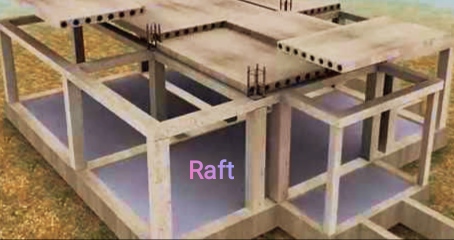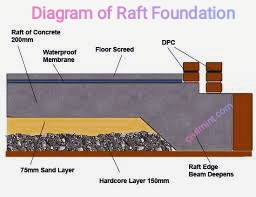Table of Contents
What is Raft Foundation?
Raft foundation also called as Mat Foundation. Raft foundation is poured on the whole area and it looks like a thick concrete mate. It is one of the most strong foundation in concrete structures.

Mat foundation support the load of whole structure and then transfer the load to soil. Raft foundation is used where soil bearing capacity is low. This type of foundation is widely used for large projects such as buildings, chimneys and large machinery.
Mat foundations can also be reinforced with beams. Such concrete slabs help reduce subsidence of structures as they withstand different moments acting due to different loading positions. Raft foundation is a large continuous slab of concrete used to transfer the full load of a structure to the ground. This continuous flat concrete slab with heavily reinforced steel supports many of the columns and walls of the structure and helps transfer loads to the ground.
With this foundation, the contact between the foundation and the ground is greater than with other types of foundations. Mat foundation helps transfer loads from the structure over a large area, and stresses on the ground are very low which also reduces structural failure due to shear.
This foundation is also very useful when the formation is unstable. It is considered a kind of shallow foundation. It also helps control uneven subsidence of structures.
Raft Foundation Diagram
In the below figure, I have shown the diagram of a typical raft foundation.

2 Important Features of Raft Foundation
Two key functions of raft foundation is listed below.
- The main function of the raft is to transfer the entire structure to a large area of the floor.
- Also reduces the differential settlement of structures.
How to Construct Raft Foundation?
Here is the step by step construction procedure of raft foundation.
- Excavation of soil to required depth and flat surface.
- The base bed is compressed properly.
- Spread the waterproof membrane over the compacted soil.
- Apply a 3 inch layer of cement sand paste to create a flat surface for the base.
- Place the reinforcing mesh on top of this layer of cement and sand adhesive at the required spacing and tie as appropriate.
- Concrete is poured to the required depth or thickness. For small structures the thickness is up to 200mm to 300mm.
- Proper curing must be done so that concrete can achieve the required compressive strength.
Types of Raft Foundation
1. Flat Plate Raft Foundation
This raft foundation is used when the column load is small and the column spacing is relatively small and uniform. The rafts provided are of uniform thickness. In this foundation, reinforcement is provided in both directions and additional rebar is provided in the locations of columns and load-bearing walls. This is the simplest form of raft foundation.
2. Plank Slab Foundation
This type of slab foundation is useful when the column is heavily loaded. In this foundation, the lower section of the column is thickened to provide adequate thickness for negative bending moments. Additional reinforcement is provided under columns and bearing walls to withstand diagonal shear and negative reinforcement.
3. Beam Slab Raft Foundation
In this type of raft foundation, two vertical beams are constructed or laid with a slab between them. This type of foundation works best when the distance between supports is very large and the sizes of the supports are unequal.
4. Pile Raft Foundation
In this type of raft foundation, piles are placed to support the raft. This type of foundation is used when the soil is highly compressible and the water table is high. Pilings also help reduce subsidence of structures and control buoyancy.
5. Cellular Pad Raft Foundation
This type of pad foundation is also called box structure. This foundation is provided so that the building foundation acts as a stiffener for the slabs within the foundation. If flexing is likely, this foundation is best for you as it can withstand high levels of flexing. This foundation is very rigid. It is also economical if the required thickness of the slab is very high.
Applications and Usage of Raft Foundation
- Raft foundations are used when the ground bearing capacity is low.
- Used when the load of a structure needs to be distributed over a wide area.
- It is economical if the foundation area is 50% of the total floor area under the structure.
- Used when the distance between columns or walls is very small. Because in this situation, the individual foundations overlap.
- Used where soil stress levels need to be reduced.
- Used for buildings that require the construction of basements.
- This footing is ideal for very compressible soil layers.
- Mainly used for the construction of commercial buildings such as showrooms, shopping malls, etc., as it requires underground space.
- Also used when the soil layer is unstable.
Benefits of Raft Foundation
- Raft foundations provide a water barrier against groundwater.
- Raft Foundation is very economical compared to other types of foundations. Very little excavation of the
- Raft Foundation is required.
- It also helps reduce subsidence of various types of structures.
- Can be used even in very poor ground conditions. The
- Raft Foundation is easy to build, no special work required.
- Combining soil and slabs, this type of foundation saves time and materials.
- A shallow foundation type that does not require deep excavation.
- The mate slab foundation is an ideal foundation for soils with low bearing capacity as this foundation expands.
- Very effective in loading compared to other strip foundations in weak soils.
- Raft Foundation mitigates cracking, subsidence, and other major structural problems. The
- Raft Foundation is very cheap and a time saver.
Raft Foundation Drawbacks
- Edge erosion can occur if handled improperly.
- Point loads also require special handling. Requires a large amount of materials or items such as steel.
- Not suitable for home use.
